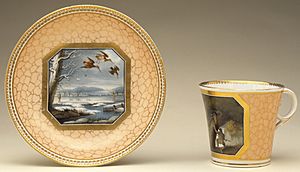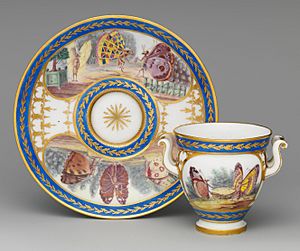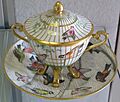Cabinet cup facts for kids
A cabinet cup is a special kind of cup, usually with a saucer, that was made to be shown off, not used every day. Imagine it like a fancy collectible! These cups were often given as gifts or bought by people who collected beautiful porcelain items. They were kept in a glass-fronted china cabinet so everyone could admire them.
What are Cabinet Cups?
Cabinet cups were most popular from the late 1700s to the early 1800s. They fit perfectly with the stylish and showy designs of that time, known as the Empire style. A more general name for these display items, including plates, is "cabinet piece."
These cups were usually decorated with very high-quality painting. This painting was done with special colors called overglaze enamel. The artists often focused on one main picture or scene, instead of just a repeating pattern. The saucer was also decorated, even the part usually covered by the cup.
Sometimes, the saucer didn't have the usual dip for the cup. This was because people often displayed the saucer standing up next to the cup. This way, you could see all the beautiful artwork on the saucer too!
Many cabinet cups were made to remember important events. This could be public events, especially those involving kings and queens. Or they might celebrate private family moments. These cups often had lots of shiny gilding (gold decoration). This showed they were not meant for heavy use, as the gold could wear off easily.

The shapes of these cups could be quite unusual and not very practical for drinking. Some even had two handles! A two-handled cup with a lid is sometimes called a "caudle cup" in England. On the European continent, similar cups were often called "chocolate cups." Caudle cups were sometimes given as gifts to new mothers.
Some cabinet pieces were shaped like mugs. They might be sold in pairs or small sets. In these cases, the main paintings on each piece would be different but would match the style. The Derby factory in England even made special small, straight-sided mugs in the 1780s. These were likely meant as cabinet pieces and featured some of their best artwork.
Many famous porcelain factories known for their beautiful painting made cabinet cups. Some factories even sold plain, unpainted cups. These were then decorated by independent artists called hausmaler. In England, Worcester and Derby were early makers. In Europe, factories like Sèvres (France), Vienna (Austria), Berlin (Germany), and Meissen (Germany) also made them.
Who Bought Cabinet Cups?
Early European porcelain factories mostly made huge, very expensive sets for royal families and their courts. England was a bit different, as its royal family didn't invest as much in porcelain.
However, starting around 1760, more and more people became wealthy. This included the bourgeoisie, or middle class. They could now afford to buy smaller, high-quality porcelain items. This led to more people becoming collectors. Glass-fronted china cabinets were already popular by the late 1600s. They were first used to display beautiful porcelain from Japan and China. Cabinet pieces were perfect for this growing market. Even very rich people bought them as extra special items. For example, George IV, when he was a prince, ordered several cabinet cups and plates in 1791.
Cabinet pieces were quite expensive. In 1771, two fancy cabinet cups were sold at an auction for £21. In comparison, a large tea and coffee set with 49 pieces only cost £7 and 7 shillings. This shows how much more valuable the special display cups were. Even famous writer Samuel Johnson bought a beautiful cabinet cup and saucer for £1 and 18 shillings. This was more than twice what he paid for a large punch bowl!
Images for kids
-
Chamberlain's factory, Worcester, c. 1805. Two-handled cup with cover, so a caudle cup type, with pastoral scene.
-
Derby, with family silhouette portraits, c. 1810
-
Sèvres cup with portrait of Louis XVIII's father, saucer with the Palace of Fontainebleau, 1822–23












